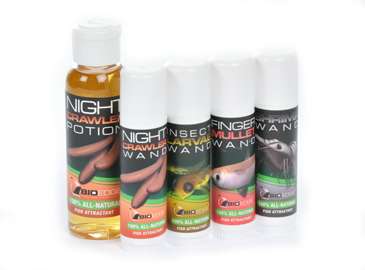
Bass have several means of finding and tracking down prey. They are sight, vibration/sound and scent. There are arguments as to which is the most important, but they all factor in on some level. Nevertheless, there are times when anglers need to appeal to one sense more than the others.
In this three-part series, we'll delve into each of the bass' senses and tell you the best ways to appeal to these senses as well as when one is more important than the others. In this first installment, we look at scent.
Bass' nostrils are found above their top lip, where you'd expect them to be. Gene Gilliland, Central Region Supervisor for the Oklahoma Department of Wildlife Conservation, says that out of all the bass' senses, scent usually takes a backseat to sight and vibration/sound.
"The conditions a bass is in determines what senses he uses more than the others," Gilliland explains. "Smell — and taste, for that matter — is a relatively short-range sense, and bass are primarily sight feeders. If they're in muddy water, vibration is a greater factor. Scent is more of a determining factor in whether or not a bass will eat a bait, not whether the fish will detect it."
Gilliland goes on to explain that bass rely on scent only after they see or feel something, then they may go closer to investigate.
"Once it's in their mouth, there are two or three subconscious decisions that take place before a fish will commit to eating something. How it feels and how it tastes and smells are a few of them," he says. "If it's a slow-moving bait that they have a chance to examine, a good scent versus a bad one can be the tipping point. However, there's a lot of conjecture as to what is good scent and what is bad scent."
What's that smell?
The bass market is inundated with products made to appeal to bass' sense of scent. There are dips, sprays, even ChapStick-looking tubes that contain some funky smelling stuff. Historically, the bass scent market has been dominated by garlic, anise and the ever-mysterious "baitfish." These three still rule the smelly roost. However, new developments are changing the odiferous landscape of bass scents.
BioEdge Fishing Products makes scents to which fish are accustomed. Bass have never been to Olive Garden and therefore don't know what garlic is or how it smells. However, there's no denying that a strange scent in the water won't entice a fish to bite. The logic behind BioEdge flies in the face of garlic and anise; it makes sense on another level.
BioEdge forgoes foreign scents and creates a product made from some of bass' favorite foods. Their scents are made using one of 15 baitfish/critters bass eat on a regular basis.
James Niggemeyer firmly believes that while garlic and anise will always be popular and effective, BioEdge is the future of scents.
"They've really got a good thing going here," the Elite Series pro says. "With BioEdge, you can get the exact bait dialed in and make a more effective and realistic presentation. Your bait already looks like a crawfish or shad or whatnot, but making it smell like one gives you an even greater advantage."
Niggemeyer has found that scent, like a bass' other senses, is more important in certain scenarios than others.
"Scents really start to shine in cold, clear water," he says. "I'm not positive why, but I have my ideas. I think they may be mouthing the baits a little more, and the smell gets them to commit. Also, in these conditions you're working you bait slower, so the bass have time to investigate your offering."
He also says that smallmouth and spotted bass are more responsive to scent than largemouth. Spots and smallies are regional fish, meaning they're found in some locales and not others. So, too, is the bait they feed on. An angler would be better served using a shad scent over a goby scent on Lake Okeechobee.
"There are herring, menhaden, goby, trout and other regional scents, but shad and crawfish would be effective nationally," Niggemeyer says. "Just look at the predominant bait in your area and you can get a scent for it."
BioEdge currently offers 15 scents for freshwater. If he could only use one, though, Niggemeyer is torn.
"It's a toss-up between the shad and the crawfish," he says. "However, I would probably lean toward the crawfish. Those are usually your slower-moving presentations, where I think scent is even more critical that fast-moving ones. It's best for jigs, soft plastics, Carolina rigs and shaky heads. I want all my baits covered in scent, but those are the most important."
Niggemeyer has two magical-sounding ways he covers his bait with scent: with a wand or a potion. BioEdge is available in a semisolid wand that has the consistency of lip balm as well as an oily potion. Niggemeyer uses the wand on crankbaits and swimbaits. He prefers the potion for skirted baits like jigs, spinnerbaits and buzzbaits. He pours it on the head then lets it run down the skirt for an even application. The potion also acts as a lubricant when applied to a punching weight and flipped into heavy cover.
"I think a lot of fishermen have been waiting for this," Niggemeyer says. "It allows us to have a more natural, believable presentation. This isn't something that's only good for tournament anglers, either," he says. "Everyone's time is valuable. If you only get to fish once a week, you want to catch fish. This gives you a leg up to maybe get that fish to hold on a second longer or totally eat the bait."
In the next installment of "Making Sense of Senses," we'll explain how bass use their lateral line and ears to hunt down their next meal.




